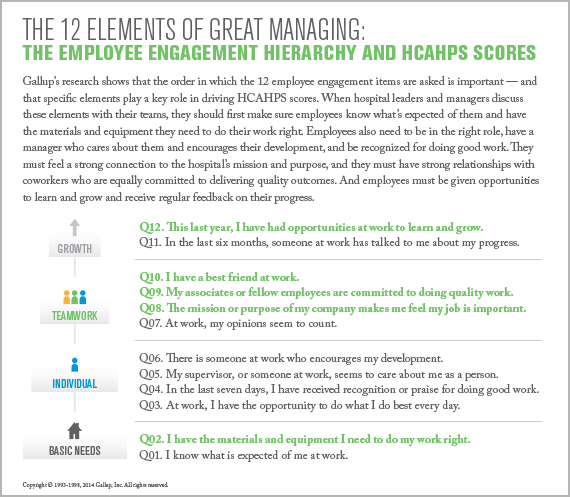Engaged healthcare workers are better able to establish an emotional connection with patients and their families.
The healthcare industry is becoming increasingly consumer-driven. Consumer-controlled health plans such as Health Savings Accounts (HSAs), Health Reimbursement Arrangements (HRAs), and Flexible Spending Arrangements (FSAs) give patients greater decision-making power in managing their healthcare budgets -- and the opportunity to become more conscientious consumers.
Health insurance exchanges also offer consumers opportunities to make side-by-side comparisons of insurance premiums and out-of-pocket figures. And government and private business are creating more options that increase the transparency of healthcare quality and cost and that contribute to the steady shift toward a consumer-driven industry.
Under this economic model, data about healthcare cost, quality of care, and patient satisfaction are more widely distributed, allowing patients to compare and select providers based on published reports, including data from the Hospital Consumer Assessment of Healthcare Providers and Systems survey, or HCAHPS. The 32-item survey, which was introduced in 2008, offers a national, standardized, publicly reported measure of patient satisfaction and was created to provide valid comparisons of hospitals nationwide.
To build and maintain patient loyalty and engagement in an era when consumers can shop around for the best value, healthcare organizations must not only provide quality care but also surpass patient expectations. Patient experience and emotional engagement are increasingly influential factors in determining healthcare providers' financial success. Fostering positive emotional connections with patients and generating strong patient engagement require employee talent and teamwork.
Healthcare employees and patients: the engagement connection
Gallup has long believed that high levels of engagement among physicians, nurses, and hospital employees are key to nurturing the critical connection between provider and patient. To analyze the relationship between employee engagement and patient outcomes, Gallup conducted a study using data collected from 48 Gallup clients who participated in both the national HCAHPS survey and Gallup's Q12 employee engagement survey. Gallup's analysis shows that high levels of engagement are linked with high HCAHPS scores in these key ways:
There is a strong positive relationship between HCAHPS scores and employee engagement. A patient's perception of care depends on his or her observations of how hospital employees perform, their level of teamwork, and their commitment to quality care. So it isn't surprising that highly engaged teams receive higher HCAHPS scores. Engaged employees are enthusiastic, excited, and willing to go above and beyond the basic standards of performance, which makes them more likely to anticipate patients' needs and create a positive patient experience. In contrast, healthcare employees who are not engaged or who are actively disengaged -- regardless of their competence in the technical aspects of patient care -- will generate lower HCAHPS scores.
Before hospital employees can engage patients, hospitals must meet workers' basic needs. The intricate connections between employee engagement and HCAHPS scores become more evident when viewed through the lens of Gallup's employee engagement hierarchy. The first steps to building engagement are ensuring that employees know what's expected of them and that they are equipped with the materials and equipment they need to do their work right. This includes not just physical resources but also intangible elements, such as training and access to job-related information. Leaders and managers must do more than state the importance of engaging patients; they must actively teach employees strategies for creating and maintaining patient engagement. This will help build teams that have the materials and preparation they need to provide patient-centered care.

Executive support of employee engagement is crucial for generating strong HCAHPS scores. Total organizational involvement in patient-centered care -- from the top down -- is related to high HCAHPS scores. Gallup's research shows that regularly measuring engagement and holding managers accountable are both essential for building and sustaining engagement. But executive support of the hospital's employee engagement effort is just as important. When all employees have a clear vision of the hospital's goals for building employee and patient engagement, they can connect to that mission and be active participants in achieving it.
Improving patient engagement
Now that hospitals' success hinges more and more on patient satisfaction, providers must find effective ways to build connections with patients and increase their engagement. Gallup recommends these six strategies for improving patient engagement:
- Engage patients at admission by discussing the process for procedures and discharge with them.
- Ensure patients understand test results by asking them to explain results back to the healthcare provider.
- Be proactive in meeting patients' needs, anticipating their needs when possible and responding quickly to their requests.
- Demonstrate empathy for patients and their families by addressing patient needs daily.
- Ensure proper communication from all providers across the continuum of care.
- Coordinate patient discharge with physicians and nurses to ensure patients are not left waiting.
Engaged healthcare workers are better able to establish an emotional connection with patients and their families than their less-engaged or actively disengaged counterparts are. By striving to create a meaningful patient experience and a strong patient connection, highly engaged employees encourage patient engagement -- giving patients a positive, meaningful experience that they will remember when rating provider performance. To thrive in a consumer-driven climate, healthcare providers must foster the provider-patient relationship, apply strategies for building patient engagement, and focus on achieving high employee engagement.
